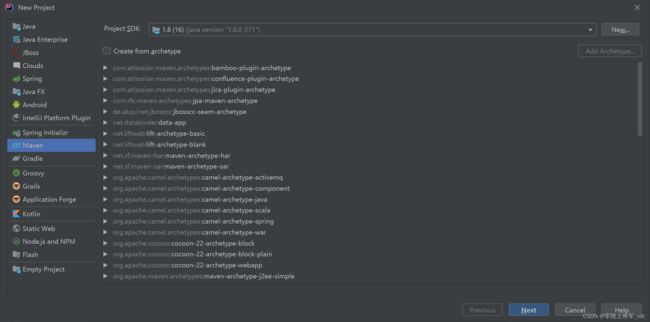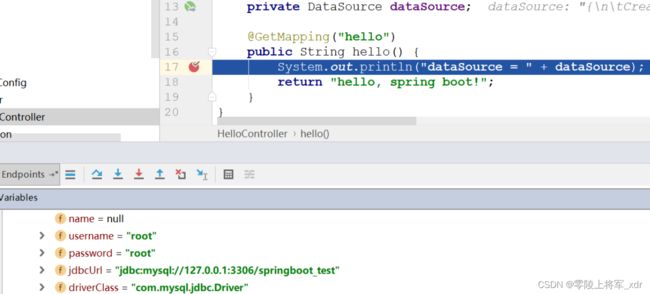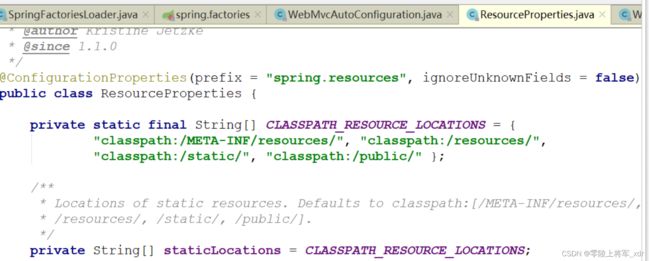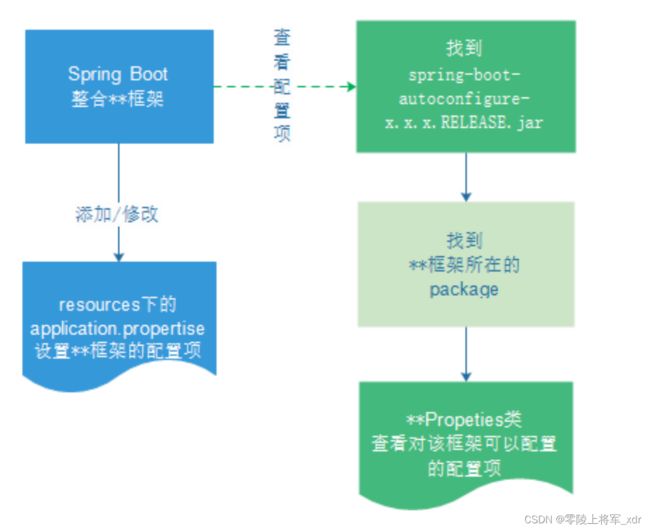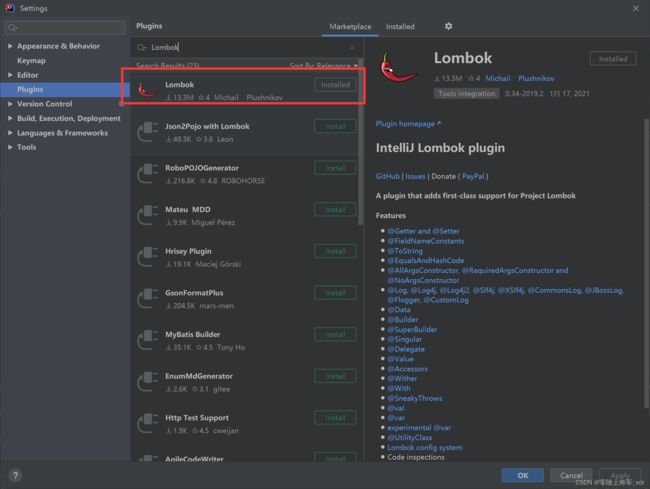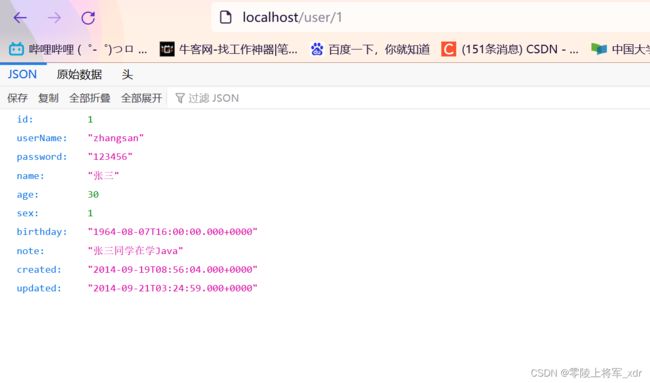Spring boot学习总结
Spring Boot概述
什么是Spring Boot
Spring Boot是Spring项目中的一个子工程,与我们所熟知的Spring-framework 同属于spring的产品:
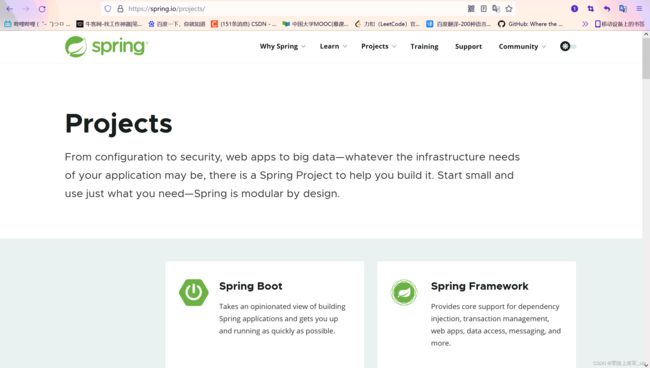
首页Spring Boot简介可以看到下面的一段介绍:
Spring Boot is designed to get you up and running as quickly as possible, with minimal upfront configuration of Spring. Spring Boot takes an opinionated view of building production-ready applications.
翻译:
Spring Boot的设计目的是让您尽可能快地启动和运行,而无需预先配置Spring。Spring Boot以一种固定的方式来构建可用于生产级别的应用程序。
一般把Spring Boot称为搭建程序的 脚手架 或者说是便捷搭建 基于Spring的工程 脚手架。其最主要作用就是帮助开发人员快速的构建庞大的spring项目,并且尽可能的减少一切xml配置,做到开箱即用,迅速上手,让开发人员关注业务而非配置。
为什么要学习Spring Boot
java一直被人诟病的一点就是臃肿、麻烦。当我们还在辛苦的搭建项目时,可能Python程序员已经把功能写好了,究其原因注意是两点:
(1)、复杂的配置
项目各种配置其实是开发时的损耗, 因为在思考 Spring 特性配置和解决业务问题之间需要进行思维切换,所以写配置挤占了写应用程序逻辑的时间。
(2)、一个是混乱的依赖管理
项目的依赖管理也是件吃力不讨好的事情。决定项目里要用哪些库就已经够让人头痛的了,你还要知道这些库的哪个版本和其他库不会有冲突,这难题实在太棘手。并且,依赖管理也是一种损耗,添加依赖不是写应用程序代码。一旦选错了依赖的版本,随之而来的不兼容问题毫无疑问会是生产力杀手。
而Spring Boot让这一切成为过去!
Spring Boot 简化了基于Spring的应用开发,只需要“run”就能创建一个独立的、生产级别的Spring应用。Spring Boot为Spring平台及第三方库提供开箱即用的设置(提供默认设置,存放默认配置的包就是启动器 starter),这样我们就可以简单的开始。多数Spring Boot应用只需要很少的Spring配置。
我们可以使用Spring Boot创建java应用,并使用java –jar 启动它,就能得到一个生产级别的web工程。
Spring Boot的特点
Spring Boot 主要特点是:
(1)、创建独立的Spring应用,为所有 Spring 的开发者提供一个非常快速的、广泛接受的入门体验
(2)、直接嵌入应用服务器,如tomcat、jetty、undertow等;不需要去部署war包
(3)、提供固定的启动器依赖去简化组件配置;实现开箱即用(启动器starter-其实就是Spring Boot提供的一个jar包),通过自己设置参数(.properties或.yml的配置文件),即可快速使用。
(4)、自动地配置Spring和其它有需要的第三方依赖
(5)、提供了一些大型项目中常见的非功能性特性,如内嵌服务器、安全、指标,健康检测、外部化配置等
(6)、绝对没有代码生成,也无需 XML 配置。
Spring boot入门
创建工程
添加依赖
Spring Boot提供了一个名为spring-boot-starter-parent的工程,里面已经对各种常用依赖(并非全部)的版本进行了管理,我们的项目需要以这个项目为父工程,这样我们就不用操心依赖的版本问题了,需要什么依赖,直接引入坐标即可!
添加父工程坐标
<parent>
<groupId>org.springframework.bootgroupId>
<artifactId>spring-boot-starter-parentartifactId>
<version>2.1.5.RELEASEversion>
parent>
添加web启动器
为了让Spring Boot帮我们完成各种自动配置,我们必须引入Spring Boot提供的自动配置依赖,我们称为 启动器 。因为我们是web项目,这里我们引入web启动器,在 pom.xml 文件中加入如下依赖:
<dependency>
<groupId>org.springframework.bootgroupId>
<artifactId>spring-boot-starter-webartifactId>
dependency>
需要注意的是,我们并没有在这里指定版本信息。因为Spring Boot的父工程已经对版本进行了管理了。
这个时候,我们会发现项目中多出了大量的依赖。
那些依赖都是Spring Boot根据 spring-boot-starter-web 这个依赖自动引入的,而且所有的版本都已经管理好,不会出现冲突。
管理jdk版本
如果我们想要修改Spring Boot项目的jdk版本,只需要简单的添加以下属性即可,如果没有需求,则不添加。同样的在 pom.xml 文件中添加如下:
<properties>
<java.version>1.8java.version>
properties>
2.3. 启动类
Spring Boot项目通过main函数即可启动,我们需要创建一个启动类:
import org.springframework.boot.autoconfigure.SpringBootApplication;
/**
* spring boot工程都有一个启动引导类,这是工程的入口类
* 并在引导类上添加@SpringBootApplication
*/
@SpringBootApplication
public class Application {
public static void main(String[] args) {
SpringApplication.run(Application.class, args);
}
}
编写controller
import org.springframework.web.bind.annotation.GetMapping;
import org.springframework.web.bind.annotation.RestController;
@RestController
public class HelloController {
@GetMapping("hello")
public String hello()
{
return "hello spring boot";
}
}
启动测试
测试成功了!
java配置应用
Spring配置历史
事实上,在Spring3.0开始,Spring官方就已经开始推荐使用java配置来代替传统的xml配置了,我们不妨来回顾一下Spring的历史:
Spring1.0时代
在此时因为jdk1.5刚刚出来,注解开发并未盛行,因此一切Spring配置都是xml格式,想象一下所有的bean都用xml配置,细思极恐啊,心疼那个时候的程序员2秒
Spring2.0时代
Spring引入了注解开发,但是因为并不完善,因此并未完全替代xml,此时的程序员往往是把xml与注解进行结合,貌似我们之前都是这种方式。
Spring3.0及以后
3.0以后Spring的注解已经非常完善了,因此Spring推荐大家使用完全的java配置来代替以前的xml,不过似乎在国
内并未推广盛行。然后当Spring Boot来临,人们才慢慢认识到java配置的优雅。
有句古话说的好:拥抱变化,拥抱未来。所以我们也应该顺应时代潮流,做时尚的弄潮儿,一起来学习下java配置的玩法。
尝试java配置
java配置主要靠java类和一些注解,比较常用的注解有:
@Configuration :声明一个类作为配置类,代替xml文件
@Bean :声明在方法上,将方法的返回值加入Bean容器,代替 <bean> 标签
@Value :属性注入
@PropertySource :指定外部属性文件,
我们接下来用java配置来尝试实现连接池配置:
- 在 pom.xml 文件中添加Druid连接池依赖如下
<dependency>
<groupId>com.alibaba</groupId>
<artifactId>druid</artifactId>
<version>1.1.6</version>
</dependency>
- 使用数据操作工具创建数据库 springboot_test
- 然后在项目中创建jdbc.properties 文件,内容如下:
jdbc.driverClassName=com.mysql.jdbc.Driver jdbc.url=jdbc:mysql://127.0.0.1:3306/springboot_test jdbc.username=root
jdbc.password=root
- 编写 JdbcConfig.java 如下
import com.alibaba.druid.pool.DruidDataSource;
import org.springframework.beans.factory.annotation.Value;
import org.springframework.boot.context.properties.ConfigurationProperties;
import org.springframework.context.annotation.Bean;
import org.springframework.context.annotation.Configuration;
import org.springframework.context.annotation.PropertySource;
import javax.sql.DataSource;
@Configuration
@PropertySource("classpath:application.properties")
public class JdbcConfig {
@Value("${jdbc.url}")
String url;
@Value("${jdbc.driverClassName}")
String driverClassName;
@Value("${jdbc.username}")
String username;
@Value("{$jdbc.password}")
String password;
@Bean
public DataSource dataSource()
{
DruidDataSource dataSource = new DruidDataSource();
dataSource.setUsername(username);
dataSource.setPassword(password);
dataSource.setDriverClassName(driverClassName);
dataSource.setUrl(url);
return dataSource;
}
}
解读:
@Configuration :声明我们 JdbcConfig 是一个配置类
@PropertySource :指定属性文件的路径是: classpath:jdbc.properties
通过 @Value 为属性注入值
通过@Bean将 dataSource() 方法声明为一个注册Bean的方法,Spring会自动调用该方法,将方法的返回值加入Spring容器中。
然后我们就可以在任意位置通过 @Autowired 注入DataSource了!
- 在 HelloController 中注入DataSource进行测试,改造代码如下:
import org.springframework.web.bind.annotation.GetMapping;
import org.springframework.web.bind.annotation.RestController;
@RestController
public class HelloController {
@Autowired
private DataSource dataSource;
@GetMapping("hello")
public String hello()
{
System.out.println("dataSource = " + dataSource);
return "hello spring boot";
}
}
Spring Boot的属性注入
属性文件的名称有变化,默认的文件名必须是:application.properties或application.yml
在上面的案例中,我们实验了java配置方式。不过属性注入使用的是@Value注解。这种方式虽然可行,但是不够强大,因为它只能注入基本类型值。
在Spring Boot中,提供了一种新的属性注入方式,支持各种java基本数据类型及复杂类型的注入。
1)新建 JdbcProperties.java ,用于进行属性注入
import org.springframework.boot.context.properties.ConfigurationProperties;
@ConfigurationProperties(prefix = "jdbc")
public class JdbcProperties {
private String driverClassName;
private String url;
private String username;
private String password;
public String getDriverClassName() {
return driverClassName;
}
public void setDriverClassName(String driverClassName) {
this.driverClassName = driverClassName;
}
public String getUrl() {
return url;
}
public void setUrl(String url) {
this.url = url;
}
public String getUsername() {
return username;
}
public void setUsername(String username) {
this.username = username;
}
public String getPassword() {
return password;
}
public void setPassword(String password) {
this.password = password;
}
}
在类上通过@ConfigurationProperties注解声明当前类为属性读取类
prefix=“jdbc” 读取属性文件中,前缀为jdbc的值。
在类上定义各个属性,名称必须与属性文件中 jdbc. 后面部分一致
需要注意的是,这里我们并没有指定属性文件的地址,所以我们需要把jdbc.properties名称改为application.properties,这是Spring Boot默认读取的属性文件名: 2)将 JdbcConfig 类原来全部注释掉或删除,修改为如下内容
2)将 JdbcConfig 类原来全部注释掉或删除,修改为如下内容
package com.itheima.config;
import com.alibaba.druid.pool.DruidDataSource;
import org.springframework.beans.factory.annotation.Value;
import org.springframework.boot.context.properties.ConfigurationProperties;
import org.springframework.boot.context.properties.EnableConfigurationProperties;
import org.springframework.context.annotation.Bean;
import org.springframework.context.annotation.Configuration;
import org.springframework.context.annotation.PropertySource;
import javax.sql.DataSource;
@Configuration
@PropertySource("classpath:application.properties")
@EnableConfigurationProperties({JdbcProperties.class})
public class JdbcConfig {
@Bean
public DataSource dataSource(JdbcProperties jdbc)
{
DruidDataSource dataSource = new DruidDataSource();
dataSource.setUsername(jdbc.getUsername());
dataSource.setPassword(jdbc.getPassword());
dataSource.setDriverClassName(jdbc.getDriverClassName());
dataSource.setUrl(jdbc.getUrl());
return dataSource;
}
}
更优雅的注入
事实上,如果一段属性只有一个Bean需要使用,我们无需将其注入到一个类(JdbcProperties,将该类上的所有注解去掉)中。而是直接在需要的地方声明即可;再次修改 JdbcConfig 类为如下代码:
package com.itheima.config;
import com.alibaba.druid.pool.DruidDataSource;
import org.springframework.beans.factory.annotation.Value;
import org.springframework.boot.context.properties.ConfigurationProperties;
import org.springframework.boot.context.properties.EnableConfigurationProperties;
import org.springframework.context.annotation.Bean;
import org.springframework.context.annotation.Configuration;
import org.springframework.context.annotation.PropertySource;
import javax.sql.DataSource;
@Configuration
public class JdbcConfig {
@Bean
@ConfigurationProperties(prefix = "jdbc")
public DataSource dataSource()
{
return new DruidDataSource();
}
}
我们直接把 @ConfigurationProperties(prefix = “jdbc”) 声明在需要使用的 @Bean 的方法上,然后Spring Boot就会自动调用这个Bean(此处是DataSource)的set方法,然后完成注入。使用的前提是:该类必须有对应属性的set方法!
Yaml配置文件
配置文件除了可以使用application.properties类型,还可以使用后缀名为:.yml或者.yaml的类型,也就是:application.yml或者application.yaml
基本格式:
jdbc:
driverClassName: com.mysql.jdbc.Driver
url: jdbc:mysql://127.0.0.1:3306/test
username: root
password: root
把application.properties修改为application.yml进行测试。
如果两个配置文件都有,会把两个文件的配置合并,如果有重复属性,以properties中的为准。
自动配置原理
使用Spring Boot之后,一个整合了SpringMVC的WEB工程开发,变的无比简单,那些繁杂的配置都消失不见了,这是如何做到的?
一切魔力的开始,都是从我们的main函数来的,所以我们再次来看下启动类:

我们发现特别的地方有两个:
注解:@SpringBootApplication
run方法:SpringApplication.run()
我们分别来研究这两个部分
了解@SpringBootApplication
点击进入,查看源码:
 这里重点的注解有3个:
这里重点的注解有3个:
@SpringBootConfiguration
@EnableAutoConfiguration
@ComponentScan
@SpringBootConfiguration
我们继续点击查看源码:
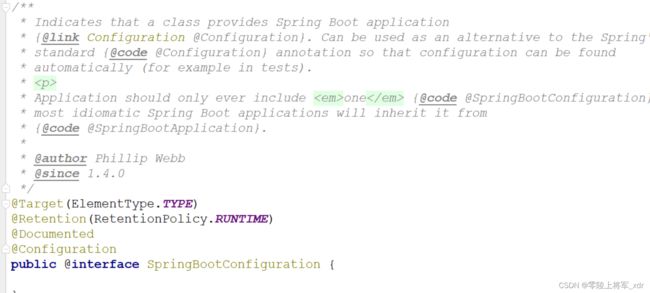
通过这段我们可以看出,在这个注解上面,又有一个 @Configuration 注解。通过上面的注释阅读我们知道:这个注解的作用就是声明当前类是一个配置类,然后Spring会自动扫描到添加了 @Configuration 的类,并且读取其中的配置信息。而 @SpringBootConfiguration 是来声明当前类是SpringBoot应用的配置类,项目中只能有一个。所以一般我们无需自己添加。
@EnableAutoConfiguration
关于这个注解,官网上有一段说明:
The second class-level annotation is @EnableAutoConfiguration . This annotation tells Spring Boot to “guess” how you want to configure Spring, based on the jar dependencies that you have added. Since spring-boot-starter-web added Tomcat and Spring MVC, the auto-configuration assumes that you are developing a web application and sets up Spring accordingly.
简单翻译以下:
第二级的注解 @EnableAutoConfiguration ,告诉Spring Boot基于你所添加的依赖,去“猜测”你想要如何配
置Spring。比如我们引入了 spring-boot-starter-web ,而这个启动器中帮我们添加了 tomcat 、SpringMVC
的依赖。此时自动配置就知道你是要开发一个web应用,所以就帮你完成了web及SpringMVC的默认配置了!
总结,Spring Boot内部对大量的第三方库或Spring内部库进行了默认配置,这些配置是否生效,取决于我们是否引入了对应库所需的依赖,如果有那么默认配置就会生效。
所以,我们使用SpringBoot构建一个项目,只需要引入所需框架的依赖,配置就可以交给SpringBoot处理了。除非你不希望使用SpringBoot的默认配置,它也提供了自定义配置的入口。
@ComponentScan
源码:

并没有看到什么特殊的地方。我们查看注释:
大概的意思:
配置组件扫描的指令。提供了类似与 context:component-scan 标签的作用
通过basePackageClasses或者basePackages属性来指定要扫描的包。如果没有指定这些属性,那么将从声明这个注解的类所在的包开始,扫描包及子包
而我们的@SpringBootApplication注解声明的类就是main函数所在的启动类,因此扫描的包是该类所在包及其子包。因此,一般启动类会放在一个比较前的包目录中。
默认配置原理
spring.factories
在SpringApplication类构建的时候,有这样一段初始化代码:
 这里发现会通过loadFactoryNames尝试加载一些FactoryName,然后利用createSpringFactoriesInstances将这些加载到的类名进行实例化。
这里发现会通过loadFactoryNames尝试加载一些FactoryName,然后利用createSpringFactoriesInstances将这些加载到的类名进行实例化。

发现此处会利用类加载器加载某个文件: FACTORIES_RESOURCE_LOCATION ,然后解析其内容。我们找到这个变量的声明:
 可以发现,其地址是: META-INF/spring.factories ,我们知道,ClassLoader默认是从classpath下读取文件,因此,SpringBoot会在初始化的时候,加载所有classpath:META-INF/spring.factories文件,包括jar包当中的。
可以发现,其地址是: META-INF/spring.factories ,我们知道,ClassLoader默认是从classpath下读取文件,因此,SpringBoot会在初始化的时候,加载所有classpath:META-INF/spring.factories文件,包括jar包当中的。
而在Spring的一个依赖包:spring-boot-autoconfigure中,就有这样的文件:
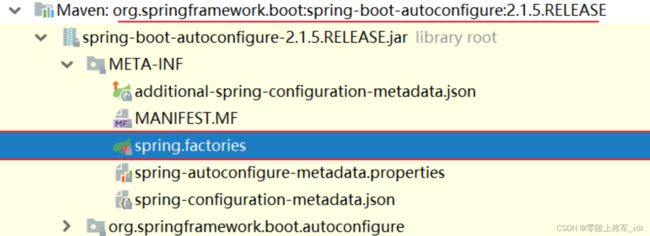
以后我们引入的任何第三方启动器,只要实现自动配置,也都会有类似文件。
默认配置类
我们打开刚才的spring.factories文件:
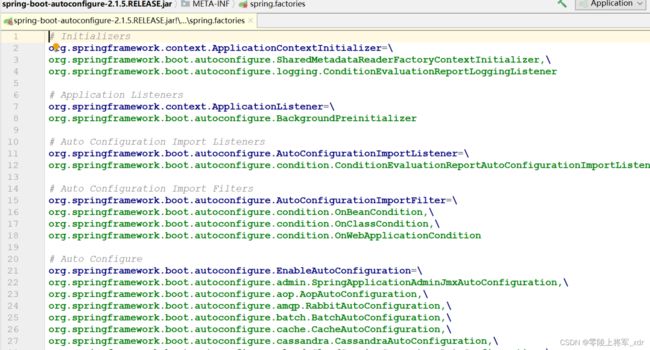
可以发现以EnableAutoConfiguration接口为key的一系列配置,key所对应的值,就是所有的自动配置类,可以在当前的jar包中找到这些自动配置类:
 非常多,几乎涵盖了现在主流的开源框架,例如:
非常多,几乎涵盖了现在主流的开源框架,例如:
redis
jms
amqp
jdbc
jackson
mongodb
jpa
solr
elasticsearch
… 等等
我们来看一个我们熟悉的,例如SpringMVC,查看mvc 的自动配置类:
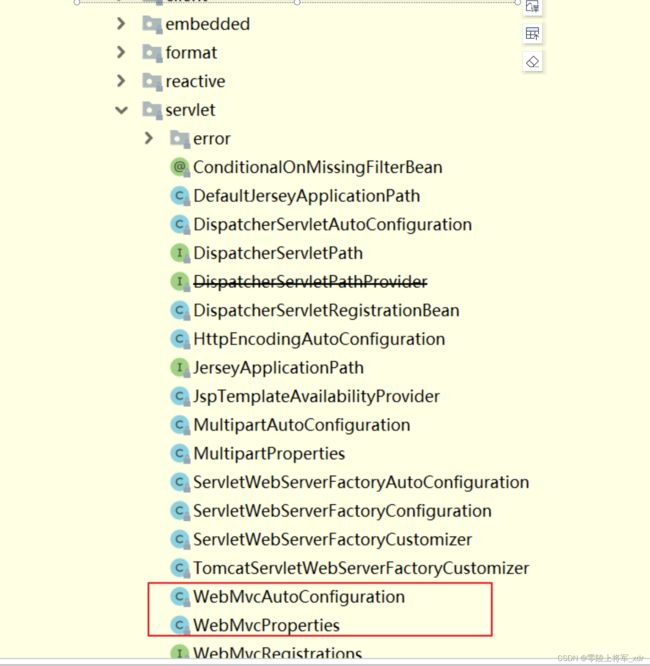
打开WebMvcAutoConfiguration:

我们看到这个类上的4个注解:
@Configuration :声明这个类是一个配置类
@ConditionalOnWebApplication(type = Type.SERVLET)
ConditionalOn,翻译就是在某个条件下,此处就是满足项目的类是是Type.SERVLET类型,也就是一个普通web工程,显然我们就是
@ConditionalOnClass({ Servlet.class, DispatcherServlet.class, WebMvcConfigurer.class })这里的条件是OnClass,也就是满足以下类存在:Servlet、DispatcherServlet、WebMvcConfigurer,其中Servlet只要引入了tomcat依赖自然会有,后两个需要引入SpringMVC才会有。这里就是判断你是否引入了相关依赖,引入依赖后该条件成立,当前类的配置才会生效!
@ConditionalOnMissingBean(WebMvcConfigurationSupport.class)这个条件与上面不同,OnMissingBean,是说环境中没有指定的Bean这个才生效。其实这就是自定义配置的入口,也就是说,如果我们自己配置了一个WebMVCConfigurationSupport的类,那么这个默认配置就会失效!
处理器适配器(HandlerAdapter):
默认配置属性
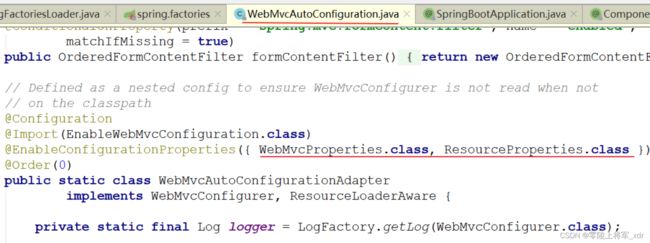 我们看到,这里通过@EnableAutoConfiguration注解引入了两个属性:WebMvcProperties和ResourceProperties。这不正是SpringBoot的属性注入玩法嘛。
我们看到,这里通过@EnableAutoConfiguration注解引入了两个属性:WebMvcProperties和ResourceProperties。这不正是SpringBoot的属性注入玩法嘛。
我们查看这两个属性类:
 找到了内部资源视图解析器的prefix和suffix属性。
找到了内部资源视图解析器的prefix和suffix属性。
ResourceProperties中主要定义了静态资源(.js,.html,.css等)的路径:
总结
SpringBoot为我们提供了默认配置,而默认配置生效的步骤:
@EnableAutoConfiguration注解会去寻找 META-INF/spring.factories 文件,读取其中以EnableAutoConfiguration 为key的所有类的名称,这些类就是提前写好的自动配置类
这些类都声明了 @Configuration 注解,并且通过 @Bean 注解提前配置了我们所需要的一切实例
但是,这些配置不一定生效,因为有 @ConditionalOn 注解,满足一定条件才会生效。比如条件之一: 是一些相关的类要存在
类要存在,我们只需要引入了相关依赖(启动器),依赖有了条件成立,自动配置生效。
如果我们自己配置了相关Bean,那么会覆盖默认的自动配置的Bean
我们还可以通过配置application.yml文件,来覆盖自动配置中的属性
1)启动器
所以,我们如果不想配置,只需要引入依赖即可,而依赖版本我们也不用操心,因为只要引入了SpringBoot提供的 stater(启动器),就会自动管理依赖及版本了。
因此,玩SpringBoot的第一件事情,就是找启动器,SpringBoot提供了大量的默认启动器
2)全局配置
另外,SpringBoot的默认配置,都会读取默认属性,而这些属性可以通过自定义 application.properties 文件来进行覆盖。这样虽然使用的还是默认配置,但是配置中的值改成了我们自定义的。
因此,玩SpringBoot的第二件事情,就是通过 application.properties 来覆盖默认属性值,形成自定义配置。我们需要知道SpringBoot的默认属性key,非常多,可以再idea中自动提示
属性文件支持两种格式,application.properties和application.yml
yml的语法实例:
jdbc:
driverClassName: com.mysql.jdbc.Driver
url: jdbc:mysql://127.0.0.1:3306/test
username: root
password: root
#tomcat端口
server:
port: 80
如果properties和yml文件都存在,如果有重叠属性,默认以Properties优先。遇到需要修改的组件的配置项流程为:
Spring Boot实践
接下来,我们来看看如何用SpringBoot来整合SSM,在数据库中引入一张用户表tb_user和实体类User。
创建 pojo\User.java 如下:
import java.util.Date;
public class User {
private String userName;
private String password;
private String name;
private Integer age;
private Integer sex;
private Date birthday;
private String note;
private Date created;
private Date updated;
public Long getId() {
return id;
}
public void setId(Long id) {
this.id = id;
}
public String getUserName() {
return userName;
}
public void setUserName(String userName) {
this.userName = userName;
}
public String getPassword() {
return password;
}
public void setPassword(String password) {
this.password = password;
}
public String getName() {
return name;
}
public void setName(String name) {
this.name = name;
}
public Integer getAge() {
return age;
}
public void setAge(Integer age) {
this.age = age;
}
public Integer getSex() {
return sex;
}
public void setSex(Integer sex) {
this.sex = sex;
}
public Date getBirthday() {
return birthday;
}
public void setBirthday(Date birthday) {
this.birthday = birthday;
}
public String getNote() {
return note;
}
public void setNote(String note) {
this.note = note;
}
public Date getCreated() {
return created;
}
public void setCreated(Date created) {
this.created = created;
}
public Date getUpdated() {
return updated;
}
public void setUpdated(Date updated) {
this.updated = updated;
}
}
Lombok
我们编写pojo时,经常需要编写构造函数和getter、setter方法,属性多的时候,就非常浪费时间,使用lombok插件可以解决这个问题:
在IDEA中安装lombok插件;不安装插件在IDEA中使用lombok的注解虽然编译能通过,但是源码会报错。所以为了让IDEA更好的辨别lombok注解则才安装插件。
<dependency>
<groupId>org.projectlombok</groupId>
<artifactId>lombok</artifactId>
</dependency>
然后可以在Bean上使用:
@Data :自动提供getter和setter、hashCode、equals、toString等方法
@Getter:自动提供getter方法
@Setter:自动提供setter方法
@Slf4j:自动在bean中提供log变量,其实用的是slf4j的日志功能。
例如;在javabean上加@Data,那么就可以省去getter和setter等方法的编写,lombok插件会自动生成。
package com.itheima.pojo;
import lombok.Data;
import tk.mybatis.mapper.annotation.KeySql;
import javax.persistence.Id;
import javax.persistence.Table;
import java.util.Date;
//在编译阶段会根据注解自动生成对应的方法;data包含get/set/hashCode/equals/toString等方法
@Data
public class User {)
private Long id;
//user_name --> userName
private String userName;
private String password;
private String name;
private Integer age;
private Integer sex;
private Date birthday;
private String note;
private Date created;
private Date updated;
}
整合SpringMVC
虽然默认配置已经可以使用SpringMVC了,不过我们有时候需要进行自定义配置。
可以在 application.yml 文件中配置日志级别控制:
#日志记录级别
logging:
level:
com.itheima: debug
org.springframework: info
修改端口
修改 application.yml 配置文件,添加如下配置:
#tomcat端口
server:
port: 80
整合jdbc和事务
spring中的jdbc连接和事务是配置中的重要一环,在SpringBoot中该如何处理呢?
答案是不需要处理,我们只要找到SpringBoot提供的启动器即可,在 pom.xml 文件中添加如下依赖:
<dependency>
<groupId>org.springframework.boot</groupId>
<artifactId>spring-boot-starter-jdbc</artifactId>
</dependency>
<dependency>
<groupId>mysql</groupId>
<artifactId>mysql-connector-java</artifactId>
<version>5.1.46</version>
</dependency>
创建 service\UserService.java 业务类如下:
package com.itheima.service;
import com.itheima.mapper.UserMapper;
import com.itheima.pojo.User;
import org.springframework.beans.factory.annotation.Autowired;
import org.springframework.stereotype.Service;
import org.springframework.transaction.annotation.Transactional;
public class UserService {
public User queryById(Long id){
return userMapper.selectByPrimaryKey(id);
}
@Transactional
public void saveUser(User user)
{
System.out.println("新增用户");
}
}
整合连接池
其实,在刚才引入jdbc启动器的时候,SpringBoot已经自动帮我们引入了一个连接池:
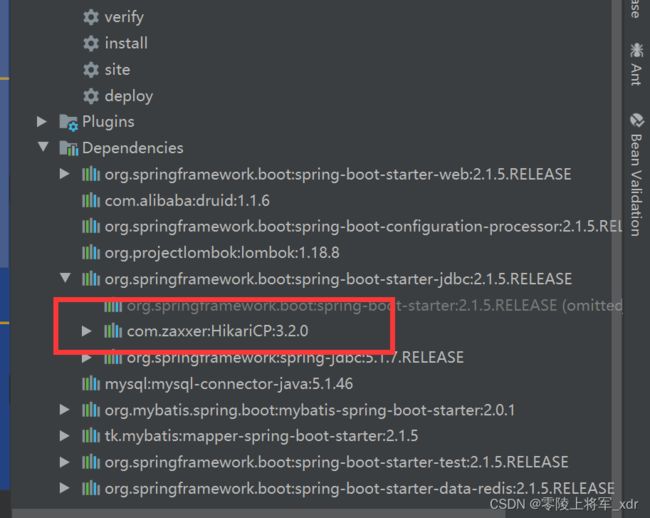
HikariCP应该是目前速度最快的连接池了,我们看看它与c3p0的对比:
因此,我们只需要指定连接池参数即可;打开 application.yml 添加修改配置如下:
spring:
datasource:
driver-class-name: com.mysql.jdbc.Driver
url: jdbc:mysql://127.0.0.1:3306/test
username: root
password: root
启动项目,访问 http://localhost/hello ;查看后台输出,一样可以在HelloController中获取到datasource。
整合mybatis
mybatis
- SpringBoot官方并没有提供Mybatis的启动器,不过Mybatis官网自己实现了。在项目的 pom.xml 文件中加入如下依赖:
<!--mybatis -->
<dependency>
<groupId>org.mybatis.spring.boot</groupId>
<artifactId>mybatis-spring-boot-starter</artifactId>
<version>2.0.1</version>
</dependency>
- 配置 application.yml ,常用配置如下:
mybatis:
# 实体类别名包路径
type-aliases-package: com.itheima.pojo
# 映射文件路径
# mapper-locations: classpath:mappers/*.xml
configuration:
log-impl: org.apache.ibatis.logging.stdout.StdOutImpl
- 配置Mapper扫描
需要注意,这里没有配置mapper接口扫描包,因此我们需要给每一个Mapper接口添加 @Mapper 注解,才能被识别。
@Repository
public interface UserMapper {
}
或者,我们也可以不加注解,而是在启动类上添加扫描包注解(推荐):
@SpringBootApplication
// 扫描mybatis所有的业务mapper接口
@MapperScan("com.itheima.mapper")
public class Application {
public static void main(String[] args) {
SpringApplication.run(Application.class, args);
}
}
通用mapper
- 通用Mapper的作者也为自己的插件编写了启动器,我们直接引入即可。在项目的 pom.xml 文件中加入如下依赖:
<!-- 通用mapper -->
<dependency>
<groupId>tk.mybatis</groupId>
<artifactId>mapper-spring-boot-starter</artifactId>
<version>2.1.5</version>
</dependency>
注意:一旦引入了通用Mapper的启动器,会覆盖Mybatis官方启动器的功能,因此需要移除对官方Mybatis启动器的依赖。
- 编写UserMapper
无需任何配置就可以使用了。如果有特殊需要,可以到通用mapper官网查看:https://github.com/abel533/Mapper/wiki/3.config
编写 mapper\UserMapper.java 如下
import com.itheima.pojo.User;
import org.springframework.stereotype.Repository;
import tk.mybatis.mapper.common.Mapper;
@Repository
public interface UserMapper extends Mapper<User> {
}
-
把启动类上的@MapperScan注解修改为通用mapper中自带的:
-
在User实体类上加JPA注解
package com.itheima.pojo;
import lombok.Data;
import tk.mybatis.mapper.annotation.KeySql;
import javax.persistence.Id;
import javax.persistence.Table;
import java.util.Date;
//在编译阶段会根据注解自动生成对应的方法;data包含get/set/hashCode/equals/toString等方法
@Data
@Table(name = "tb_user")
public class User {
@Id
//主键回填
@KeySql(useGeneratedKeys = true)
private Long id;
//user_name --> userName
private String userName;
private String password;
private String name;
private Integer age;
private Integer sex;
private Date birthday;
private String note;
private Date created;
private Date updated;
}
对 UserService 的代码进行简单改造
import com.itheima.mapper.UserMapper;
import com.itheima.pojo.User;
import org.springframework.beans.factory.annotation.Autowired;
import org.springframework.stereotype.Service;
import org.springframework.transaction.annotation.Transactional;
@Service
public class UserService {
@Autowired
private UserMapper userMapper;
public User queryById(Long id){
return userMapper.selectByPrimaryKey(id);
}
@Transactional
public void saveUser(User user)
{
System.out.println("新增用户");
int i = userMapper.insertSelective(user);
System.out.println(i);
}
}
启动测试
将 HelloController 进行简单改造:
import com.itheima.pojo.User;
import com.itheima.service.UserService;
import org.springframework.beans.factory.annotation.Autowired;
import org.springframework.web.bind.annotation.GetMapping;
import org.springframework.web.bind.annotation.PathVariable;
import org.springframework.web.bind.annotation.RestController;
import javax.sql.DataSource;
@RestController
public class HelloController {
@Autowired
private DataSource dataSource;
@Autowired
private UserService userService;
/**
* 根据用户id查询用户
* @param id 用户id
* @return 用户
*/
@GetMapping("/user/{id}")
public User queryById(@PathVariable Long id){
System.out.println(userService.queryById(id));
return userService.queryById(id);
}
@GetMapping("hello")
public String hello()
{
System.out.println(dataSource);
return "hello spring boot";
}
}
整合Redis
在 pom.xml 文件中添加如下依赖
<dependency>
<groupId>org.springframework.boot</groupId>
<artifactId>spring-boot-starter-data-redis</artifactId>
</dependency>
配置 application.yml 文件
spring:
redis:
host: localhost
port: 6379
编写 测试代码:
import org.junit.Test;
import org.junit.runner.RunWith;
import org.springframework.beans.factory.annotation.Autowired;
import org.springframework.boot.test.context.SpringBootTest;
import org.springframework.data.redis.core.RedisTemplate;
import org.springframework.test.context.junit4.SpringRunner;
import java.util.List;
import java.util.Set;
@RunWith(SpringRunner.class)
@SpringBootTest
public class RedisTest {
@Autowired
private RedisTemplate redisTemplate;
@Test
public void test1()
{
// String字符串
redisTemplate.opsForValue().set("str","java");
System.out.println("str = " + redisTemplate.opsForValue().get("str"));
// hash 散列
redisTemplate.boundHashOps("h_key").put("name","xiaoming");
redisTemplate.boundHashOps("h_key").put("age",18);
// 获取所有域
Set set = redisTemplate.boundHashOps("h_key").keys();
System.out.println("hash散列的所有域:"+set);
//获取所有值
List list = redisTemplate.boundHashOps("h_key").values();
System.out.println("hash散列所有域的值:"+list);
// List列表
redisTemplate.boundListOps("l_key").leftPush("c");
redisTemplate.boundListOps("l_key").leftPush("b");
redisTemplate.boundListOps("l_key").leftPush("a");
// 获取全部元素
list = redisTemplate.boundListOps("l_key").range(0,-1);
System.out.println("list列表中的所有元素:"+list);
// set 集合
redisTemplate.boundSetOps("s_key").add("a","b","c");
set = redisTemplate.boundSetOps("s_key").members();
System.out.println("set集合中的所有元素:"+set);
// sorted set 有序集合
redisTemplate.boundZSetOps("z_key").add("a",100);
redisTemplate.boundZSetOps("z_key").add("b",10);
redisTemplate.boundZSetOps("z_key").add("c",1);
set = redisTemplate.boundZSetOps("z_key").range(0,-1);
System.out.println("zset有序集合中的所有元素:"+set);
}
}
